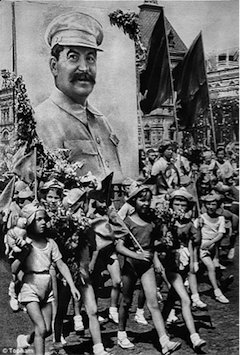

|
The Cult of Stalin  The Cult of Stalin Stalin's growing domination of the Party and the country was reflected in the cult of his personality. Stalin took a personal interest in its promotion. The cult began with the celebration of his 50th birthday in December 1929. But it took off in the summer of 1933, when Stalin's image started to appear alongside that of Lenin in the press and public spaces and he was depicted as the only true disciple of the founder of the Soviet state. Details about Stalin's life had been kept secret, but with the launching of his cult the hagiography was released. Stalin was depicted as the architect of Socialism, as a wise and paternal teacher of the nation, as a humble man with a close relationship to the ordinary people. Formerly reclusive, he now appeared in public frequently. Photo-opportunities with Soviet heroes were not missed. In 1934 huge publicity was given to his meeting with the crew of the ice-breaker Cheliuskin and the air pilots who had miraculously rescued them after their ship sank in the Arctic. From 1935 the Soviet media featured Stalin's 'Kremlin meetings with the people'. Stakhanovites, delegations from the republics and the widows of Red Army heroes took part in these stage-managed rituals, widely reported in the press, in which Stalin's appearance was greeted by a outburst of emotion and applause. How effective was the cult? Without opinion polling it is hard to say. Many people remained sceptical. They came from every quarter of society. During the famine Ukrainian peasants sang: No cows But millions of people looked to Stalin as a protector from injustice and the embodiment of all their hopes. He was a Soviet Tsar. |
© 2014 Orlando Figes | All Rights Reserved